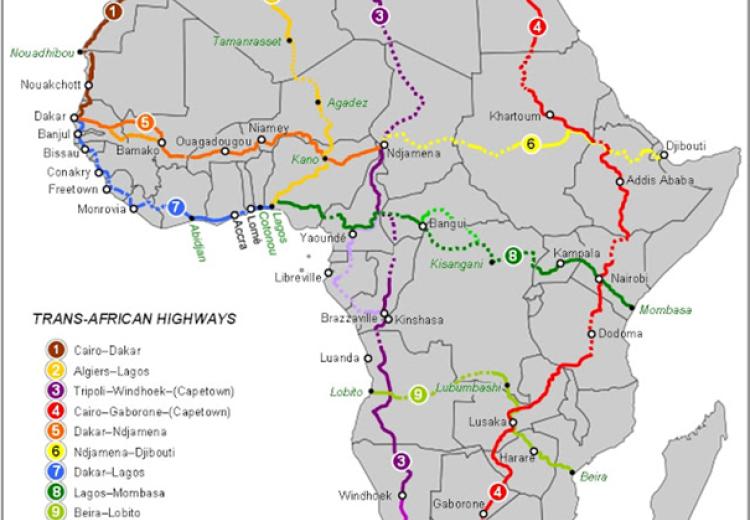Mbarara - Kisangani Road Network, part of Lagos - Mombasa Trans-African Highway will no longer be a dream
There is a new-found Political will and High-level Commitments by the Democratic Republic of Congo (DRC) and the Republic of Uganda to develop and upgrade the Northern Corridor Road Sections of Mbarara-Bushenyi-Kikorongo-Mpondwe-Kasindi-Beni-Komanda-Kisangani (940Km). This is part of the Trans-African Highway (TAH) Network N0 8 from Lagos, in the Federal Republic of Nigeria to Mombasa, in the Republic of Kenya, that is expected to open the whole of Africa to interstate trade.
In July 1971, the UN Economic Commission for Africa (UNECA) launched the Trans-African Highway Project between Lagos, Nigeria and Mombasa, Kenya, as a pilot project to make it possible to draft principles and methods for effective intra-African co-operation in the construction of international highways.
Bottlenecks to the completing of the planned TAH include but not limited to difficult terrain and climate conditions, inadequate funding for Road maintenance and upgrades as well as insecurity due to civil conflicts that have damaged roads that now require reconstruction. However, with the current high political will between partner states, this project seem to be a reality.

The huge shortage of African transport infrastructure and logistics services poses a major challenge to the continent’s development. As populations grow and investment increases, the pressure exerted on the current infrastructure is increasing. African road networks carry hundreds of billions of dollars of goods every year, but tend to link cities to ports rather than connecting the continent’s many hinterlands.
The African Union (AU), through the New Partnership for Africa’s Development (NEPAD), an AU economic development programme, is responsible for coordinating the development and realisation of the ten (10) planned Trans-African Highways Networks. Its broader Programme for Infrastructure Development in Africa (PIDA) has absorbed the project.
The Trans-African Highway N0 8 which is contiguous to TAH N0 7 in Lagos, was expected to cover a total 6,259 km shared among 6 countries as follow; 737 km in Nigeria, 1,044 km in Cameroon, 1,319 km in the Central African Republic (CAR), 1,561 km in DR Congo, 740 km in Uganda and 1,100 km in Kenya. TAH 8 is complete in Nigeria, Cameroon Uganda and Kenya. However, there are missing links in the Central African Republic and DR Congo thus preventing its complete use. Together TAH 7 and TAH 8 form the east to west African highway of 10,819 km.
The Northern Corridor Transport Coordination Authority steps up its efforts to advocate for the missing infrastructure links
The Democratic Republic of Congo (DRC) and the Republic of Uganda are committed to prioritise the development of the Mbarara-Mpondwe-Kisangani Road section of the Northern Corridor Road Network and tasked the Northern Corridor Secretariat to take the lead in fast-tracking bilateral discussions and Funds Mobilisation. They pledged to undertake bilateral consultations to work together on joint project preparation efforts and feasibility studies.
In this framework, two delegations from the Northern Corridor Secretariat led by Mr. OMAE NYARANDI, the Executive Secretary, undertook consultations with high level Government officials in DRC and Uganda in October and November 2018, respectively, to get updates on all the Transport Infrastructure projects and trade facilitation initiatives in both countries, and most importantly, promote joint bilateral efforts between the two Northern Corridor Member States to develop the Mbarara-Mpondwe-Kisangani Highway.

NCTTCA Delegation led by Mr. OMAE NYARANDI, Executive Secretary, in working discussions with Hon. Monica AZUBA NTEGE, Minister of Works and Transport, Kampala, Uganda, 13th November 2018.
The political will and commitment by the two Northern Corridor Member States after the consultations were also a result of a strong and unanimous directive by the 30th sitting of the Northern Corridor Council of Ministers held in Mombasa, Kenya, on 3rd August 2018, tasking the Northern Corridor Secretariat to work closely with the Member States of the Republic of Uganda and the Democratic Republic of Congo to jointly mobilise funds in order to promote cross-border transport infrastructure, especially the upgrading of the Mbarara-Kisangani Road Network.
The Northern Corridor Transit and Transport Agreement (NCTTA), a treaty between the Member States of the Northern Corridor countries of Burundi, Democratic Republic of Congo, Kenya, Rwanda, South Sudan and Uganda, provides a regional framework for cooperation on transport infrastructure development, interstate and transit trade facilitation and further related issues between the Member States. The main objective of the Northern Corridor Agreement signed in 1985 and later assented to by South Sudan in 2012, is to guarantee Member States free passage of transit traffic through their respective territories.
Under Article 4 (I, III and IV) of the Agreement, the contracting parties undertake to establish and manage transport and communication systems that are viable, reliable and efficient; cooperate in investment planning, develop development of transport and transit facilities and jointly seek financing for project execution; and harmonise their standards and procedures for designs, construction, operation and maintenance of transport and transit facilities and equipment.
The Northern Corridor Treaty established the Northern Corridor Transit and Transport Coordination Authority (NCTTCA) to oversee the implementation of the Agreement.The NCTTCA was therefore mandated by its Member States to transform the Northern corridor into an economic development corridor through Spatial Development Programme and making the corridor a seamless, efficient and smart Corridor.
It is in this context that the Authority has identified the Mbarara-Kisangani as one of the missing links. Once constructed, it can spur economics as well as promote intra-regional trade by exploiting the massive untapped economic potential in the region.
The first formal bilateral Meeting between DRC and Uganda’s top Senior Government officials, at Ministerial level, with selected Development Partners will be organized in the first Quarter of 2019.

